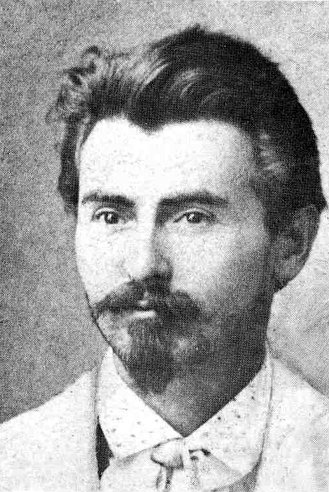
1872–1952
He was educated at the Kharkiv Technical Railway School. From the age of 19 he was an assistant to Kharkiv city architect Alfred Spiegel.
In 1903 a competition was held in Poltava for the construction of a provincial zemstvo building. Vasyl Krychevsky proposed a project based on the traditions of folk architecture. The building of Poltava Zemstvo is decorated with coats of arms with national Ukrainian motifs and inscriptions in Ukrainian. This is how Vasyl Krychevskyi introduced the Ukrainian style in architecture.
After moving to Kyiv, he became the first to start creating his own scenography in the Ukrainian theater, discarding decorative draperies and the same fences with tiles for different performances.
Since 1907, working as the chief artist of the Mykola Sadovsky Theater, for two years, he has designed a number of performances from the Ukrainian and world classical repertoire. Among them: “Bohdan Khmelnytskyi” by M. Starytskyi, “Taras Bulba” by M. Lysenko, “Uriel Acosta” by K. Gutskov and others.
For the first time he introduces architectural construction on the Ukrainian stage as an element of the performance’s design.
After the February Revolution, Krychevskyi participated in the organization of the Academy of Arts, the rector of which he became.
At the same time, he received an artistic order from a friend Mykhailo Hrushevskyi, now the President of the Ukrainian People’s Republic, to urgently (in a week!) develop state symbols of the UPR. Thus, Krychevskyi created symbols that are still relevant for Ukraine.
Already in 1925, as an expert of Ukrainian folk art, he was invited by VUFKU to be a consultant and do scenic design a large-scale film “Taras Shevchenko”. He later made a large number of films, and even debuted as a cameraman in 1932 – the film “The Way is True”.
In June 1939 he was awarded (simultaneously with his brother Fedir) the degree of Doctor of Arts. Since 1940 (also together with his brother) – Honored Artist of the USSR.
In 1940, a large individual exhibition of his works was organized in Kyiv, which had 1055 exhibits.
After the war, Krychevskyi left Ukraine. The last 5 years of his life he lived in Caracas, the capital of Venezuela.
Here is what is mentioned about him at the end of his life: “The artist, due to his abilities, took part in public work. He read for the Ukrainian community reports on Ukrainian church art, Ukrainian architecture, the history of Ukrainian carpets and their ornaments. He designed stages and made sceneries for Ukrainian performances. He gave his advices during rehearsals for the play “After the Audit”, which was prepared by members of the Association of Ukrainian Women in Venezuela. Although he was aware that the disease was incurable, Krychevskyi did not succumb to it, painted and painted, leaving behind paintings-masterpieces.
He died of pneumonia in 1952, shortly before his 80th birthday. He was buried in Caracas according to Ukrainian custom. After some time, the artist was reburied in the Ukrainian cemetery of St. Andrew in Bound Brook, New Jersey, USA.